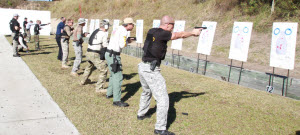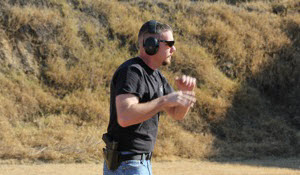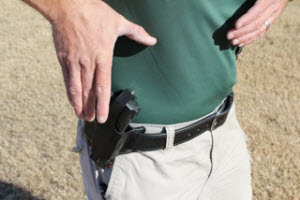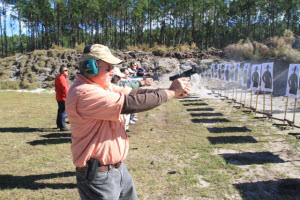Photos by Mike Seeklander and Rob Pincus
 I
painfully watched my student get shot. The rounds impacted his upper
chest area in perfect placement, even though the bad guy was shooting
from a grounded position with only one hand. The bad guys have all the
luck. Fortunately, this was not a real fight, only a simulated one
during a class I was teaching. Why had the bad guy even gotten his shots
off—after all, this was a well-trained student with great firearm
skills? The answer was because of a training error that had not been
fixed until that moment.
I
painfully watched my student get shot. The rounds impacted his upper
chest area in perfect placement, even though the bad guy was shooting
from a grounded position with only one hand. The bad guys have all the
luck. Fortunately, this was not a real fight, only a simulated one
during a class I was teaching. Why had the bad guy even gotten his shots
off—after all, this was a well-trained student with great firearm
skills? The answer was because of a training error that had not been
fixed until that moment.After the fact, the student finally learned the key lesson that he had been told so many times on the range and would certainly never do again. This was the reason we were doing those scenarios, utilizing a bit of stress and NLTA (non-lethal training ammunition). Nothing teaches like getting shot! This article will cover why my student got shot that day, as well as other errors I have observed while training hundreds of students in both combative and competitive type classes.
Bad Habit #1: Shooting without a Purpose.
This is a big one, and unfortunately pretty common. Each and every repetition you do in training continues to build up the efficiency of that nerve transmission. But if the repetitions you do are incorrect, you will train this into your subconscious memory. When you need the skill in a future situation where you are under stress, your brain will draw from what it knows or has ingrained, and if you trained improperly, you will perform improperly. Your training drills should be planned based on the results you want.
Simply shooting your gun and hoping you are learning the right skills is a waste of your time. To fix this, take some time and list the skills you will likely need, and then prioritize them. Develop some training drills that will work on each of those skills, and use them during your training sessions. If you don’t know what skills you might need, or don’t have a good understanding of how to perform those critical techniques correctly, then find a good instructor before you waste your time and ammunition training the wrong way.
 Bad Habit #2: Not training realistically.
Bad Habit #2: Not training realistically.(Photo: Beware of doing too much static range training. Keep it real!) I watch people practice all the time, and rarely do I see someone who is dedicated to making their training sessions as realistic as possible. For example, if you are training with your handgun to prepare yourself for a critical incident, you should do some of your training with your heart rate very high, to simulate what you may experience during a fight. Getting your heart rate up can be as simple as performing some sort of exercise (link sprints or squats) for a minute or two before you draw and shoot.
A similar failure that I observe regularly is training statically—in one comfortable standing position. During a fight where the use of a firearm is justified, it’s highly likely that you will be moving or in a non-standard position. You might be shooting from the ground. If you spend 90% of your workday driving in a vehicle, it’s conceivable that you might be attacked while seated in that vehicle. If you have never trained for that possibility, you are simply not training for reality. To fix this, take some time to figure out where you are most likely to have a problem that requires the use of your firearm, and then train in that environment or condition.
Bad Habit #3: Performing ritualistic movements during static range training, leading to improper actions under stress.
This is the habit that got my student shot in the scenario described above. He’d spent a good portion of the class going through a visual after-action scan process that I’d taught, but he failed to pay attention to the details behind the action. Instead of actually looking and assessing, this student would shoot, immediately whip his finger off the trigger when the last round had been fired, and then quickly begin shifting his head back and forth, probably seeing nothing. This is what I call a “range scan,” one that is often done to appease the instructor instead of serving the purpose of finding another threat.
When training alone and without a purpose, a student may think he is training the right moves, but not connecting with the reasons behind the moves can build bad habits. The first step in the scan process that I teach is to scan the threat, which means that we take the time to stay in the fight and follow through after we have made the decision to stop shooting. Think about how this will go down in real time: you decide to shoot someone based on justification, then shoot them until they no longer pose a threat, and only when you have deemed that threat neutralized do you begin your scan process. This normally means that the threat has fallen down or ceased their actions.
The important part of this process is looking for and receiving information that allows us to make the decision to continue to shoot or stop shooting. Paper targets don’t shoot back, so shooting three to five times and then immediately taking your finger off the trigger and beginning to scan has no penalty. Doing that with a real person does, and in the case described above, had dire consequences for the student in the scenario.
In the scenario, the student engaged until the threat fell down, but unfortunately, the bad guy had not been neutralized. He was still fully armed and able to shoot the student several times before the student recognized this and returned fire. Had he simply followed through and stayed in the fight for a few more seconds, my student would have recognized this and continued shooting, truly neutralizing the threat.
 Bad Habit #4: Short cutting – not the same gear, not snapped in, not concealed.
Bad Habit #4: Short cutting – not the same gear, not snapped in, not concealed.(Photo: This shooter carries concealed only, and is training with an exposed firearm. Fouling the garment sweep is often the cause of bad draws.) This one absolutely drives me insane. I have trained hundreds of students in different firearms courses, and this always amazes me. Failure to train with what you are going to fight in can and will lead to your demise in a critical incident. When I teach a combative handgun course, I always start with a gear lecture that covers the pros and cons of different carry methods, gear set ups, etc. It is during this first lecture that I ask the group how many of them will be carrying their firearm concealed and how many will be carrying openly.
Most civilians in all but a few states must conceal their firearm in order to carry it on their person, so normally most of my civilian students raise their hand. When I later observe them on the range during the class training, oftentimes they are not attempting to conceal their gun. When asked why not, they have no good excuse. I know that it’s more work to draw from concealment and a carry holster than from a slick kydex holster on a competition belt, but what are you training for? My answer: I train to develop as much skill as I can, accompanied by consistent performance on demand with the gun and gear worn exactly how I will carry it.
 (Photo:
Training the draw process while failing to use the locking devices on
the holster could have grave consequences in a critical incident.)
Law enforcement and military students who use duty-type systems often
fail to snap their holsters during each repetition of the draw process,
just because getting through those retention devices is more difficult.
What are they training for? Failure? Failing to train as close as
possible to how you plan to fight is a critical error that can cost you
your life. I have personally witnessed the same students fouling up
their draw fighting with a concealment garment or a snap-on holster. If
only they had put in the work, they would have perfected their draw and
been able to execute it on demand!
(Photo:
Training the draw process while failing to use the locking devices on
the holster could have grave consequences in a critical incident.)
Law enforcement and military students who use duty-type systems often
fail to snap their holsters during each repetition of the draw process,
just because getting through those retention devices is more difficult.
What are they training for? Failure? Failing to train as close as
possible to how you plan to fight is a critical error that can cost you
your life. I have personally witnessed the same students fouling up
their draw fighting with a concealment garment or a snap-on holster. If
only they had put in the work, they would have perfected their draw and
been able to execute it on demand!Bad Habit #5: Ignoring the reality check and context.
By this, I mean using tactical gear and items that would not be used in a real-life situation, not training for what is most likely, and/or not having a complete understanding of what might occur. I taught a rifle class some time ago, and I surprised the students when I did not wear a tactical vest, dump pouch, drop holster, or really any cool-looking tactical gear at all. Instead, I simply slipped my handgun magazine forward a bit on my belt, clipped a rifle magazine pouch to my belt, slung my rifle, and kept my normal carry holster on. I explained to them that I prefer to train as I will likely fight. Slinging my rifle and clipping a preloaded rifle magazine pouch on would probably be the only things I had time to do, if I even got a chance to grab my rifle in the first place.
 (Photo:
This minimally kitted-out shooter is doing it right—training with what
he’s likely to have on him in a critical incident.) A SWAT or
military operator might have completely different reasons to have their
full kit on since they deploy with that gear, but civilians who train
with full ninja gear might be creating unrealistic expectations. Take
the time to do a reality check on the gear you’re training with. A
specific example from my personal experience is that if and when I
deployed a rifle for self-defense, I would not have time to put on a
special holster (drop type). This requires me to transition to my
handgun from an appendix carry position, which is certainly more
difficult than transitioning to a hip or leg position. Had I not done a
reality check, I might have spent my training time using a leg or hip
holster, which is a waste of my training time because I will not likely
deploy my rifle while wearing a thigh holster.
(Photo:
This minimally kitted-out shooter is doing it right—training with what
he’s likely to have on him in a critical incident.) A SWAT or
military operator might have completely different reasons to have their
full kit on since they deploy with that gear, but civilians who train
with full ninja gear might be creating unrealistic expectations. Take
the time to do a reality check on the gear you’re training with. A
specific example from my personal experience is that if and when I
deployed a rifle for self-defense, I would not have time to put on a
special holster (drop type). This requires me to transition to my
handgun from an appendix carry position, which is certainly more
difficult than transitioning to a hip or leg position. Had I not done a
reality check, I might have spent my training time using a leg or hip
holster, which is a waste of my training time because I will not likely
deploy my rifle while wearing a thigh holster.Another reality check is to think about what is most likely to occur during a fight for your life, and then train for those situations. I am amazed at how many students I have had who never realized that they might be involved in a physical fight that prevents them from accessing their firearm. They are amazed to find that they might have to deal with the fight first, before they can get to their gun. When talking about fitness and combatives, I often hear the answer “I’ll just shoot them” from students who have no skill with their personal striking weapons (hands, feet, etc) or are unfit. The problem is that getting to the gun in most of those situations is harder than they ever thought possible with an aggressive attacker striking their head. Have you ever tried to draw and shoot someone while they were punching you in the face?
A bit of research quickly shows what situations are most likely to happen, and how they will probably go. Simply do your research and train to the most likely situations. Prepare for what will likely happen versus what you would like to happen! Shooters often make the grave mistake of thinking they can apply a shooting solution to all self-defense related problems, which is incorrect.
Review
In closing, let’s review what you can do to avoid developing these bad habits:
- Pre-plan your training sessions and perform valid, skill-producing drills. Have a plan for each session, and a goal you would like to reach. Work on the areas you are weak in.
- Train as realistically as possible. Get creative. Consider combining your fitness and firearm training sessions to get maximized results for your time.
- Take the time to understand and apply the reasons behind what you’re doing in training. If you’re performing a post-engagement scan, know why you’re doing it and mimic the correct actions you want yourself to learn. Use visualization to make this training as realistic as possible.
- Don’t shortcut your training by using gear improperly, failing to conceal your firearm if you carry it that way, or training with gear you won’t be using when you are faced with a critical incident. Snap your holster each time you practice your draw!
- Take the time to do a reality check on the gear you’re using and the situations you’re training for. Prioritize your training appropriately.
These are all good tips, but some are not realistic for regular training at most gun ranges. I don't know a single range in my area that allows for drawing and shooting or allows prone shooting. Range masters here are strict weaver stance only. Some don't even allow shooting at silhouette targets.
ReplyDeleteThe draw-and-shoot drill can be dangerous, especially for CC holsters. Yes, that's even more reason to train for it, but be warned: DON'T TRY THIS without proper instruction and safety precautions.